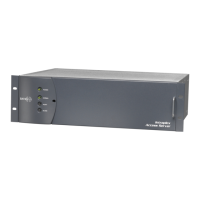5 – Remote Control ACS-160 Series & STL-160 Series T1 Multiplexer Installation & Operation
Version 2.11, August 2011
Harris Corporation 5-31
Intraplex Products
recommended. In an expansion shelf, set the address of each channel module to its physical slot
number plus 18. For example, a channel module located in physical slot 4 of an expansion shelf should
be assigned a card address of 22.
Remote communication with channel modules located in ACS-165 drop and insert multiplexers can
only take place through the remote port of the DI-A CM-5RB module. Channel module commands
received by the DI-B CM-5RB are ignored.
In a dual terminal multiplexer, each CM-5RB module communicates only with the channel modules in
its section of the multiplexer. Each terminal operates independently of the other. However, an alert or
alarm generated by either terminal creates an alert or alarm condition on the shelf.
5.2.3.5 Channel Module Status
To determine a given channel module’s status in an ACS-160 Series multiplexer, issue a STATUS?
command in this form:
<Address>:Cn:STATUS?:;
where n is the number of the target channel module. For example, to request the status of channel
module #4 in multiplexer #15, issue the command:
15:C4:STATUS?:;
The sub-address field in channel module STATUS? commands is always of the form Cn, regardless of
whether the module is located in a terminal or a drop and insert multiplexer.
The response to a valid channel module STATUS? command indicates whether the module is in an
alarm or alert state, and may provide other information as well, depending on the specific channel
module type. The response always takes this general form:
* OK
CHANNEL CARD nn, TYPE mmm
(one or two lines indicating Alert/Alarm conditions, if present, followed by one or more lines
stating the values of each “S” [status] parameter);
Table 5-10 shows a response to a STATUS? command sent to a PT-150A program audio transmitter.
Table 5-10. Typical STATUS? Response and Meaning
Response Meaning
* OK A valid command was received.
CHANNEL CARD 3, TYPE 194 Channel module # 3 is a PT-150A module *
S01 = 1 (B00000001) The left channel analog input is active.
S02 = 0 (B00000000) The right channel analog input is idle.
S03 = 0 (B00000000) The left channel input is not in overload.
S04 = 0 (B00000000); The right channel input is not in overload.
* The channel module type, located in the second line of the response, is a number assigned by
Intraplex to each different type (generally, each different model) of remotely controllable channel
module. The individual channel module manuals contain the type number and definitions for the “S”
(status) parameters maintained by each type of channel module.
5.2.3.6 Line/Module Redundancy STATUS? Messages
The STATUS? message response is
:::;
<CR>
* OK

